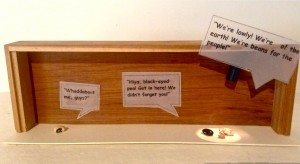Adventures in Lighting
Construction no.2 is fitted with a tiny spotlight that shines on a set of beans made important in the essay “Beans and Me” by Jeremy Jackson from Alone in the Kitchen With an Eggplant: Confessions of Cooking for One and Dining Alone (ed. Ferrari-Adler 2008). In the essay’s story, the author imagines an interaction among anthropomorphized pinto, lentil, black bean, and black-eyed pea—the latter bean is left out of the limelight in an imagined scene.
Constructing the scene required the coordination of box size and intensity of light for the spotlight. There is, I discovered, a relationship between object and light that relates to the “inverse square law,” that is, that light falls off, inversely, with the square of the distance. This “law” came to my attention after an adventure into Radio Shack for the electrical materials to create a spotlight for a very tiny space. Radio Shack and electronics go together and I assumed that the local mall retailer and its staff would guide my adventure. Not so. After showing my box and quest to light it to who seemed to be the “manager,” she directed me toward a confusion of drawers with all sorts of wires, lights and other paraphernalia. As she stepped away from me, she smugly said she had no idea how any of those elements worked together. Well, how about the other teen aged employees? The young man shyly smiled with an absent look on his face, and the young woman was “very busy” at the moment, but she dropped the hint that the tiny lights with their mysterious wires need to be connected to a battery source. Of course I ought to know about the wonderful world of electronics, but at the moment any schooling on the subject was dim. I messed around those drawers for more than a half hour with excursions to the battery section of the store attempting to match up lamps with battery holders with battery voltages. I settled on a 6 volts mini lamp (a tiny light bulb with wiring) and a cool little plastic box with on/off switch that holds 4 “AA” batteries, each 1.5 volts to equal a corresponding 6 volts for the lamp. I took the pile of items to the busy young woman and she offered a “this should work” assessment. I didn’t spend much money but the self-education was priceless. I’ve always been fond of Jean Piaget’s premise that “to understand is to invent,” and here I had the chance to “invent” a connection of materials that would potentially create a spotlight for my box construction. Although my efforts of invention compare to a very elementary understanding of electronics, I experienced a sense of fulfillment as I left the store, clutching my Radio Shack parcel. But the lack of staff help made me wonder about the health of this retailer. A New York Times web search came up with the news that Radio Shack is in turmoil; last fall its chief executive stepped down following a 21 million dollar loss despite the retailer’s shift toward the smartphone market. The Internet is surely a wicked competitor, but I bemoaned the fact that others will be denied the chance to mess around a drawer of paraphernalia in a brick and mortar “store” as I did and “invent” an electronic connection. A tutorial on electric circuits like this one from Red River College offers post invention reflection: http://www.youtube.com/watch?v=b3XS4lAxvrc
There was elementary thrill in connecting wires and seeing the little light blink on. I drilled a hole in back of the box to thread the wires through, glued the beans in place, and added call outs for the beans printed on vellum. But, oh my, here is where the inverse square law came into play. The tiny light was diffused across the bottom of the box and hardly spotlighted the trio of beans. I contemplated, “spotlight, spotlight,” then google imaged the term. Right, they have a lens tube that directs the light, limiting diffusion. I sawed off the end of a common pen top to create a black tube, fitted it with electrical tape and, well, see the spotlight effect?

